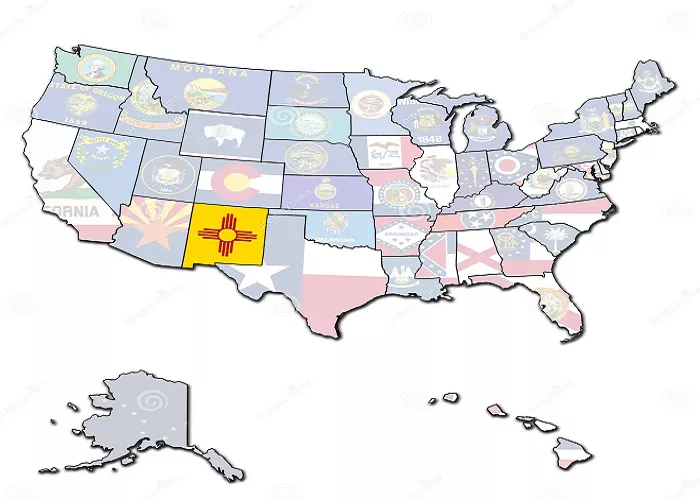New Mexico is a state located in the southwestern region of the United States. It shares borders with several U.S. states and Mexican states, making it a unique blend of cultures and landscapes.
Geographic Location of New Mexico
New Mexico is situated in the southwestern part of the United States. It shares its northern border with Colorado, its eastern border with Oklahoma and Texas, its southern border with the Mexican states of Chihuahua and Sonora, and its western border with Arizona.
The state’s geographical coordinates are approximately 34.0° N latitude and 106.0° W longitude.
This positioning places New Mexico among the Mountain States, highlighting its varied topography that includes both mountainous regions and expansive deserts.
New Mexico’s Borders and Neighboring Regions
New Mexico’s extensive borders connect it to various U.S. states and Mexican states:
- North: Colorado.
- East: Oklahoma and Texas.
- South: The Mexican states of Chihuahua and Sonora.
- West: Arizona.
This strategic location not only makes New Mexico a gateway between the U.S. and Mexico but also positions it as a significant state within the Mountain West subregion.
Major Cities and Landmarks in New Mexico
New Mexico encompasses several notable cities and natural landmarks:
- Santa Fe: The state capital, known for its Pueblo-style architecture and vibrant arts scene.
- Albuquerque: The largest city, situated along the Rio Grande, serving as a major cultural and economic center.
- Las Cruces: Known for its proximity to the Organ Mountains and as a hub for agriculture.
- Roswell: Famous for its association with UFO lore and the annual UFO Festival.
- Carlsbad Caverns National Park: Located in the southeastern part of the state, renowned for its extensive cave system.
New Mexico’s Physical Geography
The state’s diverse terrain includes:
- Rocky Mountains: Dominating the northern part of New Mexico, offering rugged landscapes and recreational opportunities.
- Great Plains: Covering the eastern regions, characterized by rolling plains and agricultural lands.
- Colorado Plateau: Located in the northwestern quadrant, featuring unique volcanic formations and dry grasslands.
- Chihuahuan Desert: Extending through the southern part of the state, it is the largest desert in North America.
- Major Rivers: Such as the Rio Grande, Pecos, Canadian, San Juan, and Gila, which play crucial roles in the state’s ecology and economy.
Climate and Natural Resources
New Mexico experiences a varied climate:
- Northern New Mexico: Features a mountainous climate with colder winters and milder summers.
- Southern New Mexico: Exhibits a semi-arid to arid climate with more significant temperature variations.
The state is rich in natural resources, including minerals like gold and silver, and has vast areas dedicated to agriculture and forestry.
Cultural and Historical Significance
New Mexico’s location has influenced its cultural and historical development:
- Indigenous Heritage: Home to several Native American tribes, each with unique traditions and histories.
- Spanish Influence: The state has a rich history of Spanish colonization, evident in its architecture and cultural practices.
- Route 66: The historic highway passes through New Mexico, contributing to its cultural significance.
Transportation and Accessibility
New Mexico’s position affects its transportation networks:
- Highways: Interstate 40 and Interstate 25 are major routes facilitating east-west and north-south travel, respectively.
- Air Travel: Airports in cities like Albuquerque and Santa Fe connect New Mexico to national and international destinations.
- Railroads: Freight and passenger rail services traverse the state, supporting commerce and tourism.
Tourism and Outdoor Activities
New Mexico’s diverse landscapes offer numerous recreational opportunities:
- National Parks: Carlsbad Caverns National Park and White Sands National Park attract millions of visitors annually.
- Outdoor Recreation: Activities like hiking, skiing, and hot air ballooning are popular among residents and tourists.
Conclusion
Understanding New Mexico’s location on the U.S. map reveals its significance as a state rich in natural beauty, cultural heritage, and economic resources. Its borders with both U.S. states and Mexican states highlight its strategic position in North America. From the towering peaks of the Rockies to the expansive deserts, New Mexico’s diverse geography offers a unique blend of environments that continue to shape its identity and allure.

